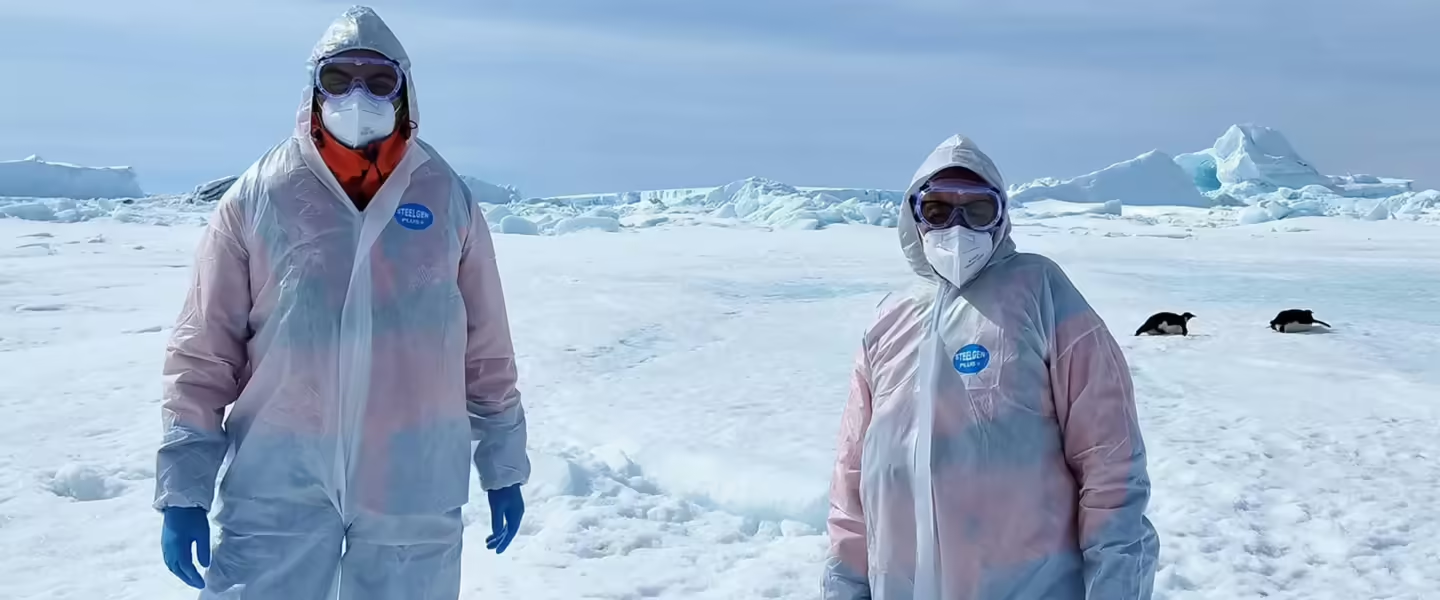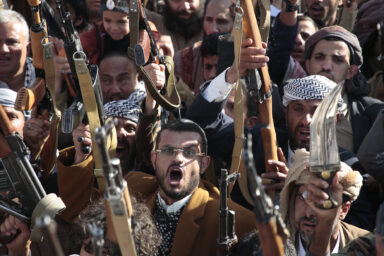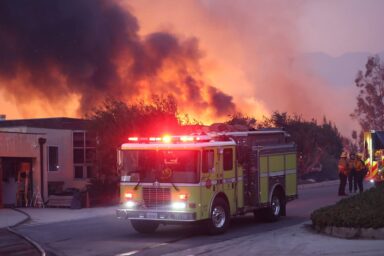Cash-strapped scientists in Antarctica face ‘unimaginable’ challenges — from sampling a lethal virus on floating ice to fighting a ‘climate’ threat that could kill millions of wildlife, and even humans. Despite calls for global assistance, 29 states meeting in India this month remain entrenched in Cold War-era secrecy.
|
Listen To This Story
|
This story by Tiara Walters was originally published by Daily Maverick and is part of Covering Climate Now, a global journalism collaboration strengthening coverage of the climate story.
•
If there are zero journalists to hear a time bomb inside a secretive Antarctic Treaty meeting, does it make a sound? And if the explosive, 90,000-word minutes are quietly announced only six months later, at the start of the festive season, will they be read?
Always closed to media and the public, and held in a different country each year, this tightly guarded session was convened by 29 states in Helsinki, Finland, over May and June 2023. Countries like Australia, China, the US, South Africa, and Russia discussed the 1959 treaty’s usual objectives — which dedicate the icy region to the aspirational ideals of peace and science. Yet, they also grappled with the imminent arrival of a highly pathogenic bird flu — one that may be fatal to birds, mammals, and humans.
The H5N1 virus would be confirmed by the British Antarctic Survey in brown skua predatory birds on South Georgia, a UK subantarctic territory, in October — just months after the meeting. These migratory birds are thought to have picked up the virus in South America, where it has ripped 6,000 km (~37 miles) across the continent since turning up there in 2022. Here, hundreds of thousands of marine birds and mammals have been left dead.
This killer virus, 400 delegates heard, posed a grave threat to more than 100 million breeding birds, six seal, and 17 cetacean species.
And while the spillover chances from wildlife are very rare, and there is still no evidence of transmission between humans, the consequences of infection could be severe.
Since 2003, this virus has killed half of 900 people infected by it, and has become better adapted to mammals. If this animal pandemic (“panzootic”) mutates into a human pandemic, its pathogenic potential could prove less, or worse, than COVID-19’s toll. The Scientific Committee on Antarctic Research (SCAR), an independent advisory body, notes mutation could have a “catastrophic effect” on the global human population.
None of the dramatic implications was lost on the delegates as they gathered behind the “ice curtain.” In fact, unbeknown to world media, the talks raised dangerous bird flu — “highly pathogenic avian influenza” or “HPAI” — more than 50 times.
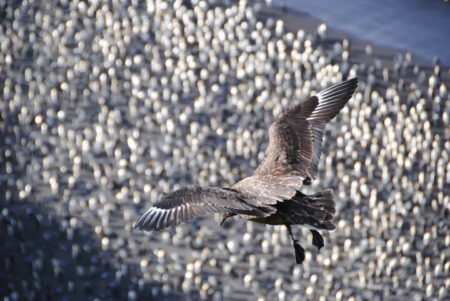
Photo credit: Tiara Walters / Daily Maverick
‘Ice Curtain’ Calls for a ‘Common Approach’
In fast-heating West Antarctica, possibly thousands of Adélie penguins found by a surveillance expedition in recent weeks now lie lifeless in the snow. The expedition, led by the Antarctic Wildlife Health Network (Scar), is still investigating the cause of death — and, yet, these frozen mass graves hint at precisely the kind of ecological crime scene forewarned by climate-induced disease outbreaks.
As revealed in the extensive meeting minutes, which have not been previously reported, outgoing chair of the Antarctic Treaty’s environmental protection committee, Norway’s Birgit Njåstad, said an outbreak was “likely and could be a detrimental threat to Antarctic wildlife.”
Chile, South Korea, the UK, and the US tabled substantive contributions, reporting they had publicly shared their stringent HPAI biosecurity protocols. A competent protocol, according to the UK’s biosecurity plan, deployed specialist staff, protective gear, and back-up stocks.
Despite these obviously laudable efforts, the talks offered a telling clue about a fragmented surveillance response. “Some parties” — the minutes noted in the usually muted language of Antarctic diplomacy — urged “competent authorities” to “develop a common approach.”
No silver bullet would naturally address the needs of national scientific programs across the profoundly complex Antarctic, but this minute item alluded to two inconvenient truths of universal relevance.
- In some ways, bird flu is actually old news in Antarctica — a WHO-led discovery first isolated the fairly harmless, low-pathogenic type a decade ago. The WHO collaboration team even described the risk of HPAI infecting the “fragile” region via migratory species like skuas, to date the Antarctic outbreak’s greatest victim. With H5N1 first isolated in China in 1996 and treaty disease talks tracing to that time, it could also be argued that states had sufficient time to coordinate, giving all scientists — from richer and poorer states — all the gear and equipment needed for dangerous, sensitive work.
- At least two parties put their subtle clarion call for a more coordinated approach on record, but they did not link their names to a concession that might be viewed as candid, or even controversial.
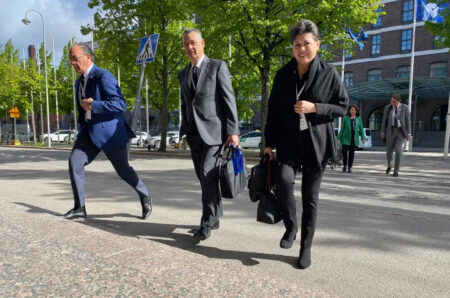
Photo credit: Tiara Walters / Daily Maverick
Extraordinary Public Interest, Press Access Denied
In February 2023, Helsinki declined Daily Maverick’s request for press conferences at the closed 45th consultative meeting, citing a consensus decision system not solely governed by Finland.
Yet, as compelled by the treaty’s environmental laws, it was already in mid-2022 that scientific committee SCAR, the International Association of Antarctica Tour Operators (IAATO), and the Council of Managers of National Antarctic Programmes (COMNAP) had launched a campaign to prevent the illegal accidental introduction of HPAI as a non-native microorganism.
This early awareness suggests treaty states had ample chance to reconsider their media exclusion policy on the grounds of extraordinary public interest. Instead, Daily Maverick was compelled to report from the venue’s doorsteps for the majority of the 10-day event.
This reporter also questioned delegates at the door about the contents of the secretive talks, but — even as the public remained unaware of the threat bearing down on the southern regions — they remained tight-lipped and did not mention the virus.
Very concerning that HPAI has now reached the Southern tip of South America.
We wrote some recommendations last year in preparation of HPAI entering Antarctica. You can find them here: https://t.co/RNJxawWXa6 https://t.co/1Z9tJG12ke— Michelle Wille (@DuckSwabber) April 6, 2023
Controlled by 29 influential states capable of mobilizing support and resources from other organizations for a global crisis that started outside Antarctica, the meeting also failed to issue a dedicated joint statement on the deadly flu threat to some 140 non-Antarctic states and the press. The event, which ended June 8, did publish a broad closing communiqué involving a variety of minute items, including a reaffirmation of Antarctica’s mining ban. It even flagged some of H5N1’s dangers, but it was not a detailed HPAI warning.
It spanned half a paragraph. And it was filed under the wrong date: May 9.
Helsinki did not provide answers to detailed questions sent repeatedly over several weeks, saying the organizing officials were now in new positions.
Saving the World by Whispering in a Broom Closet?
Even if the risk is low, best practice involves notification about the potential of human infection. However, meeting statements by host state Finland, tourism body IAATO, and the Antarctic and Southern Ocean Coalition (ASOC), the treaty’s independent environmental observers, also failed to cite H5N1’s 50% human mortality rate.
But maybe, in ASOC’s case, that point was moot, because they did not actually mention the virus — only flagging it nearly five months later in a statement titled “ASOC Closing CCAMLR-42 2023 PR.” (This statement was about the Antarctic Treaty System’s October/November fisheries meeting, and even seasoned reporters might have mistaken its cryptic headline for a poker tournament announcement).
Acting on the instructions of the 29 states, the treaty secretariat only announced the 90,000-word Helsinki minutes half a year after the meeting — and nearly two months after the virus erupted in the Antarctic region. There was nothing unusual about the treaty custom picking the festive season to release a document at least a thousand times longer than the average press release. However, it does suggest that — regardless of the issues of the day — there was no appreciable urgency to share them with the media, or the international public.
Happy holidays from the Antarctic Treaty Secretariat to you and yours! ❄️ pic.twitter.com/s2g4HvLdfZ
— AntarcticTreaty (@AntarcticTreaty) December 14, 2023
The definitive version of the Final Report of the 45th #Antarctic Treaty Consultative Meeting (held in Helsinki, Finland, 2023) has been published and is available for download from https://t.co/6wpqDu1mKf.
Read more: https://t.co/kTyssQD7H8 pic.twitter.com/88efNmW6QB
— AntarcticTreaty (@AntarcticTreaty) December 14, 2023
The tabled HPAI papers were unlocked on the secretariat archive directly after the meeting. None of these revealed the transcripts from the live debate chambers — sealed off to the press since Uncle Sam led the Cold War-era push that gave us the demilitarization treaty at the end of the 1950s. They were also tucked in among hundreds of other unrelated documents tabled at the meeting, and not flagged as priority information of global public interest.
They were, in other words, only likely found by experts who knew they were there — a catch-twenty-flu situation, one might say.
ASOC, the world’s only non-profit environmental advocacy group with a backstage pass to consultative meetings, told us they “did not comment at the time of [the meeting] as we did not have anything substantive to add to the response by other organizations and their infectious disease experts.”
IAATO said their guidance — issued in advance of two tourism seasons that attracted roughly 220,000 tourists — was “created in consultation” with SCAR. Communications director Hayley Collings said the body’s guidance and accompanying resources directed would-be visitors to the World Organisation for Animal Health (WOAH) for further advice — these resources were also made available via the IAATO website and member operators.
(Even so, SCAR and COMNAP, in a June advisory coinciding with the month of the Helsinki meeting, explicitly outlined the potential human costs.)
The Antarctic Treaty, which has no official media spokesperson, declined to comment. However, a South African government spokesperson told us the upcoming consultative meeting in India from May 20 to 30 “is closed.”
We asked the Indian host secretariat why, despite their consequence, the 2024 bird flu talks would also thwart media. After eight emails sent since March 26, we received a brief response — “portions” of the opening ceremony would be “open” and “broadcast.” No “broadcast” details were given.

Photo credit: Tiara Walters / Daily Maverick
The United Nations of Antarctica? It’s a Question of ‘Human Rights’
To prevent escalation of fractious power competition that could further damage the Antarctic environment, there may be valid reasons for diplomatic confidentiality.
However, do such justifications clarify how a system that reinforces its “ice curtain” precedents year upon year would manage and communicate more outbreaks in a time of climate change?
Just your periodic reminder that it’s now TWO MONTHS since @AntarcticTreaty’s annual closed door meeting and the public still has not been given an account of it. Yes, really. An IGO governing a whole continent can’t manage contemporary communication. #IceCurtain. pic.twitter.com/8SlYTMcfHG
— Andrew Darby (@looksouth) August 23, 2021
If it seems there are no easy answers, the French scientist Dr Valérie Masson-Delmotte delivered an elegant coup de grâce for transparency in Helsinki. Delivering a presentation at the treaty’s first climate day, Masson-Delmotte, an IPCC co-chair at the time, also uploaded her slides to X, the social media site.
“I decided to release my slides and a summary of my presentation online, through social networks,” Masson-Delmotte told us. “I also informed the delegates of this choice of transparency during a long Q&A session after my presentation.”
IPCC sessions may also be closed, but external observers provide detailed reports. UN meetings held daily live press conferences and allowed broader, accredited civil society engagement, said Professor Nicholas King, an IPCC Fifth Assessment Review editor.
Also a UN science panel co-chair to UNEP’s Global Environmental Outlook, King described the treaty system as “an outdated anomaly among more recent multilateral treaties designed to deal with issues of a transboundary nature and global significance — which the future of Antarctica very much is.”
King urged: “The global community needs to come together through the UN to force changes to a fully open, multilateral Antarctic oversight treaty which negotiates transparently and undertakes decisions in the best interest of the planet and all peoples, in line with the objectives of the UN Charter on Human Rights.”
Like the UN, which demonstrates a somewhat healthier, if imperfect, relationship between confidentiality and public communication, other Antarctic conferences offer tried-and-tested hybrid models. SCAR’s “Antarctic Science: Crossroads for a New Hope,” to be hosted in Chile in August, will have closed business meetings but run a rich public education program over four days.
‘Unimaginable Challenges: Sampling On Floating Sea Ice’
In March, a Chilean team of surveillance experts made a milestone, if tragic, announcement — they had confirmed H5N1 in Adélie penguins and cormorants on the Antarctic Peninsula, which faces South America. They had joined forces with researchers from France and Monaco, as well as the Czechian base on the peninsula, which reported the suspected cases.
Dr Fabiola León spearheaded the landmark analysis, and told Daily Maverick the confirmation illustrated why “border-transcending” cooperation was crucial in this far-flung frontier. Their lab had unlocked a biosecurity budget long before the virus’s Antarctic outbreak, explained León, who is affiliated with, among others, the BASE Millennium Institute — a Chile government program. Chilean researchers had launched surveillance as early as January 2023.
Their confirmations followed the historic Argentine-Spanish effort that isolated the first Antarctic mainland cases in February. However, while the Argentine and Czechian bases were on high alert and played the critical role of reporting the suspected cases, they lacked capacity for full sample analysis. The Argentine team shipped skua samples to their Spanish neighbors, who did the analysis instead. At the Czechian post, there were no wildlife specialists trained for sample collection and preparation, so the Chile team traveled there themselves. They braved thousands of kilometers.
“The sampling covered both island and continental locations located in the Weddell Sea, Bellingshausen Sea, Amundsen Sea, and Ross Sea,” said Dr Elie Poulin, director of the BASE Millennium Institute, which worked with the Chilean Antarctic Institute. “In this sense, the campaign’s journey covered more than 5,000 km (~3,100 miles).”
León painted a picture of working in an extreme and remote outdoor laboratory like no other.
“As researchers, we often face unimaginable challenges such as sampling on floating sea ice, enduring extremely cold temperatures, and going without food and restroom breaks for up to eight hours during sampling,” the virologist recalled about her 2023/24 fieldwork. “In other instances, we may find ourselves working in isolated research stations with limited resources. These conditions demand meticulous planning, specialized equipment, and skilled personnel.”
Report of an Antarctic expedition to investigate the spread and impact of highly pathogenic avian influenza H5N1 on wildlife in Antarctica. @nienkebeintema of @nrc interviews Dutch members of the expedition team. Part of @KappaFlu research. #vogelgriephttps://t.co/cPYFD25AUv
— Thijs Kuiken (@thijskuiken) April 12, 2024
Scientists On the Front: The Strain of Ecological Grief
Just weeks before researchers from across the world were due to head south for the season, it would surface that only about 12 members from the COMNAP council — which convenes 33 national Antarctic programs — had proper plans in place.
These revelations emerged a month after the Helsinki talks at a SCAR workshop of frontline researchers, held in the Antarctic gateway of Christchurch, New Zealand.
During a 200-minute recording freely uploaded to YouTube by SCAR and COMNAP’s website, other preparedness worries came to light, including fears about reporting lines and political tensions if the virus were to rear a potentially divisive head in areas with many national stations.
The workshop was also informed that H5N1’s Antarctic incursion via migratory species was unavoidable — and that the pressure cooker of climate change was the chilling, silent, and insidious culprit.
“Infectious disease is increasing in wildlife due to climate change — we’ve been warned for many years,” said Dr Meagan Dewar, chair of SCAR’s Antarctic Wildlife Health Network (AWHN), which unearthed the penguin mass graves in March. Their three-week mission, co-funded by IAATO, pioneered a fast-detection onboard diagnostic lab — a first for Antarctica.

Photo credit: Christian Clauwers / Clauwers.com / Daily Maverick
When we asked workshop participant Dr. Michelle Wille where scientists needed help, she said she was encouraged by cooperation among many national programs, but said capacity could “improve across the board.” She also rattled off an Antarctic virologist’s wishlist, which asked for more financial support to dispatch trained staff for an outbreak response, as well as enhanced shipping and permitting to ensure samples are transported swiftly to accredited labs. Covering costly items like PPE, kits, and reagents, her list included dedicated funding for sample testing.
Besides the deep disappointment of canceled wildlife studies so soon after COVID-19, deemed necessary to avoid non-essential contact with animals, there was also the matter of processing emotional stress.
“Many of my colleagues from around the world have been shocked by the scale of mortality events,” added the AWHN’s Wille, who has tirelessly churned out daily HPAI tweets on her @duckswabber X account. “I’ve heard tales from colleagues in Europe, watching almost all individuals in a seabird colony die or disappear, and my colleagues in South America seeing dead sea lions, kilometer after kilometer upon beaches.”
“I think we are all collectively struggling with ecological grief and are speaking as loudly as we can,” said Wille. “It has been very challenging to convey the level of mortality to the public, as well as the implications of these mortality events. Scientists are speaking widely to media outlets as best as possible.”
Meanwhile, on South Africa’s Marion Island, which supports half the world’s breeding wandering albatrosses, Professor Nico de Bruyn noted the island’s researchers had taken their own initiative to introduce biosecurity in the absence of government protocols. The South African government confirmed theirs would only be tabled in India next month.
Pretoria University Professor Marthan Bester, a leading polar mammal authority, feared a grim outcome might face the subantarctic territory’s elephant seals. If the virus hit, “bitterly few” would survive.
COMNAP executive secretary Michelle Rogan-Finnemore did not respond to repeated requests for comment about preparedness challenges. Answers were also not received from the Argentine, Czechian, and Spanish bases.
‘We Chose Hope’
For William Muntean, the former head of the US delegation to the Helsinki meeting, national programs have done as well as can be expected. Since the flu’s incursion, some countries have issued individual statements, including Australia, Chile, Spain, the UK, and the US.
The minutes show that Muntean and his delegation from the US — the treaty depositary — took a lead role at the meeting to address the potentially “devastating consequences.” They proposed measures for detection and prevention, urging cooperation, the “highest biosecurity,” and data exchange.
“No scientist said at the Antarctic Treaty Consultative Meeting that human vectors such as tourism or scientists were the only pathways for HPAI to arrive in Antarctica,” Muntean continued.
“Therefore, officials at the ATCM could at best be hopeful that actions taken by relevant groups to reduce those risks would slow the introduction of HPAI to the region,” he told us.
Muntean noted: “They also chose to be hopeful that the limited monitoring ability combined with behavior modifications would significantly reduce if not eliminate the risk of transmission of HPAI from wildlife to humans.”
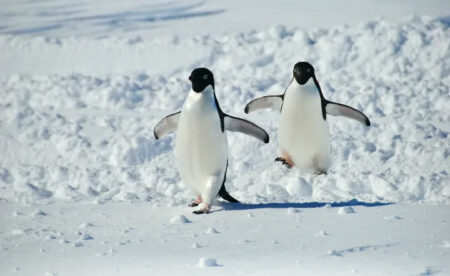
Photo credit: Tiara Walters / Daily Maverick
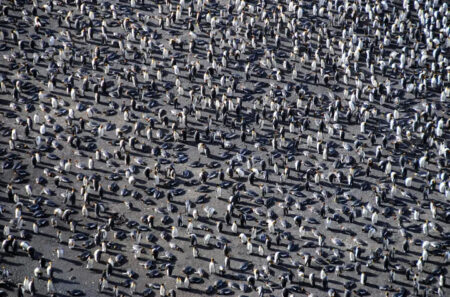
Photo credit: Tiara Walters / Daily Maverick
The World Cannot Wait for Spring
As animals disperse, the 2023/24 breeding season has now drawn to a close. Professor Ashley Banyard, head of the virology division at the UK’s Animal and Plant Health Agency, which confirmed the first Antarctic cases, and sent additional help to South Georgia, hoped the worst of the virus had “burnt out” in the island’s seals, after causing mass deaths there.
Either way, when the Long Dark Night retreats in spring, and the sun’s tentacles creep back over the ice, virologists will be vigilant for a new ecological chapter. The sun, for eons a sign of renewal, could now signal ruin for a vast and complex community of life for which there may be no more safety in numbers.
Upcoming seasons, BASE Millennium Institute researcher Dr Fabiola León said, would be best tackled with drone mapping and proactive surveillance across vulnerable species. Singling out Antarctic specially protected areas, León called for intensified surveillance, biosecurity enforcement, and restrictions — which required increased budgetary support for specialized teams across Antarctica.
A “primary rationale” for mobilizing resources was anchored in the ethical mandate to safeguard the biodiversity and essential ecosystem services of every Antarctic species.
Waiting for spring could be too late.
“I suggest that specialized scientific groups be mobilized, laboratory equipment be provided in Antarctic scientific bases, and continuous surveillance be established even before the breeding season,” León said. “This surveillance should involve a population census, symptom monitoring, and detection of viral prevalence and load in both flying and non-flying birds.”
It was, in a word, a matter of universal concern.
“The issue of the H5N1 outbreak on the Antarctic continent,” León said, “should be a matter of priority where all countries worldwide could contribute.”
